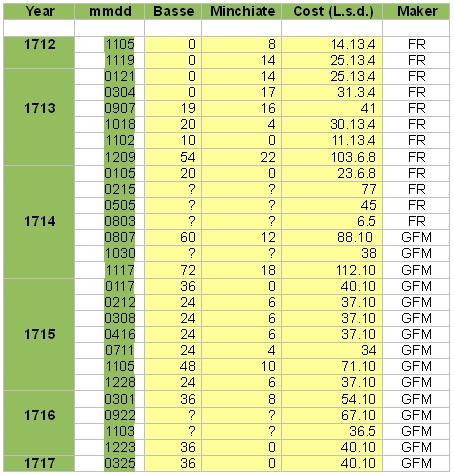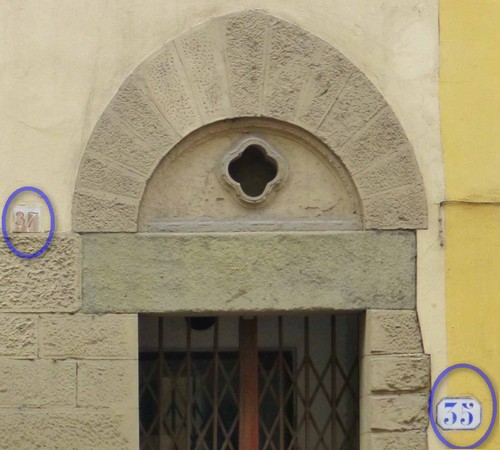INTRODUCTION
The two main centres in Florence, in which a theatre had been established, with rooms associated for parties and playing, were Casino dei Nobili and Teatro del Cocomero. Contrary to the similar situation in other Tuscan towns, however, there were several minor such centres active at the same time, at least since the end of the 17th century. Some information on those founded earlier on by Accademia dell’Evangelista(1) and Accademia degli Aquilotti(2) has already been reported.
Here the attention is focused on Accademia dei Cadenti, with theatre and rooms in Corso Tintori, in the Santa Croce area. This part of the town had been the most active for the renowned Florentine manufacturing of textiles and other products. We are interested in the beginning of the 18th century, however, and at the time the manufacturing activity had lost much of its incidence.
It was not difficult to find ancient workshops dismissed there, with wide workrooms easy to modify into halls and reception rooms. It is thus not surprising that several small theatres and academies found their seat in this area. The difficulty in studying the situation from this point of view is that there was not one such traditional place, as in other parts of the town; there were instead several of them, often short-living.
Accademia dei Cadenti
The sources for this note have been two detailed studies by Francesca Fantappič. The more recent one is a scholarly article of about fifty pages, with no less than 169 exhaustive footnotes.(3) A special attention has been provided to the difficult study of finding the exact places around the Santa Croce church, in which all the activities studied took place in the course of time. As usual among professional historians, the attention of this author is focused on the organisation of performances, and the major contribution is in the sector of the history of the Florentine theatres.
Actually, most of the buildings involved are still existing, but nothing remains that can be used as a witness of the past activity, except for archival documents. That research had already provided interesting results in a previous work of the same author.(4) She first used a lot of documents and could thus reach a new insight into the situation, with original information that had not been taken into account in the current histories of the Florentine theatres and academies.
For the time we are interested in, the beginning of the 18th century, Fantappič has studied the first registers of the section “Libri di commercio e di famiglia”, kept in the Archivio di Stato di Firenze (ASFI).
|
“Il materiale reperito, conservato nel fondo Libri di commercio e di famiglia dell’Archivio di Stato di Firenze, č costituito da sette registri, prevalentemente contabili, relativi agli anni compresi tra il 1707 e il 1719, dei quali tre sono relativi all’Accademia dei Cadenti, tre a quella dei Sorgenti e uno ad entrambe. Devo la segnalazione a Daniela Sarŕ, che intendo qui ringraziare.”(3) |
I am not yet interested in the Accademia dei Sorgenti, which manly was just an offshoot of that examined here. Therefore, only five of the seven mentioned books will be used in this study. By the way, an eight folder kept in the same series actually comes from the Accademia dei Semplici, of Prato, and has already been studied for another note.(5)
That playing cards was a current activity in this academy had not escaped the attention of Fantappič, who even indicates some pages of the registers, in which the corresponding records can be found. What for her has been a part of minor relevance, becomes for us the main section, and this study is thus limited to expand what she has briefly reported about it.
As soon as I could check these registers, the first impression was of disappointment, because I expected to find a much richer documentation. As a whole, we are in front of a few pages, and with few records.
The archive group and the relevant section
The archive section “Libri di commercio e di famiglia” is a very heterogeneous group, in which 1770 items of various nature can be found, mainly from the 16th to 18th centuries. Fortunately, a detailed Inventory has been compiled recently, (6) and a couple of ledgers with data on the production of playing cards in Florence were already studied starting from it. (7)
The registers we are interested in now are precisely the first books of the section. Let us examine them in some detail – which will not be a verbose description, also because of their thinness.
In using the mentioned Inventory, I will not repeat for all their titles that they are “dell’Accademia dei Cadenti”. Most pages were numbered as folios; however in most cases they were numbered “alla veneziana”, in the way of Venice: instead of using the same number for front and back sides of each folio, the same number was used for the left and right page of the open book.
No. 1 – 1707-1717. Book of minutes. Register. 31.5x21.8cm; 87 folios; blank 18 and 80-87.
This is in principle the most important of these registers, because it contains the minutes of all the meetings of the academy. Unfortunately, most of the contents consist in lists of the members, who attended the meetings; absent members were listed too, with the additional information whether they had given a reason for the absence – if not, a fine was recorded that they had to pay to the academy.
As a result, much of the documentation is only useful to let us understand how active the membership was – not very much in general, considering that a remarkable part of the meetings could not assume any decision, because the number of attending members was too low.
Nevertheless, we obtain from these minutes some useful information, also in our field of games. For instance, we read discussions on a Trucco (an early form of billiard) to be rented, then to be given back to its owner; or complaints because some card players continued their games after the closing time.
No. 2 – 1707-1713. Debtors and creditors. Register. 30.4x21.8cm; 48 folios, 1-15 alla veneziana; blank 16 and 39-48.
This register is formed by two different sections, the first of the years 1707 and 1708, the second starting with 1712. Actually, a new academy – which we are interested in - was established in 1712, with fifteen members, out of which only four had been members of the previous academy; in the following years their number increased to about twenty.
The main contents are lists of membership fees given, or to be given, by every member of the academy; usually, two pages, side by side, are dedicated to each member. The list begins with the first instalment, and often the remaining space is left blank.
No. 3 – 1712-1717. Debtors and creditors, and cash book. Register. 32x23.5cm; 88 pages, 1-10 numbered normally, then mostly unnumbered, with some blank pages at the end.
This is the most detailed of the registers and has been the source of the quantitative information on playing cards of the following table. The records have been inserted according to their nature – we thus find long lists of money taken from the cash boxes, with lists interposed for expenditure in repairs or various purchases.
Among the expenses, purchases of cards have been recorded, even though in several cases the association with which cards, and how many of them, is not stated.
No. 4 – 1714. Income and expenditure. Register. 22x15cm; 94 folios; 1-36 alla veneziana; blank 37 and 39-94.
This is a cash book of a smaller format. Most entries are records of the money drawn out of the cash boxes for Trucco and cards. Sometimes trades of playing cards are recorded too, but with a reference to the corresponding receipts, absent here, and without any useful detail.
In the course of time, it seems that the two cash boxes were differently associated with the various games played; for instance, sometimes we find Minchiate associated with Trucco - in other cases with Trentuno.
No. 5 – 1717. “Giornale”. Register. 35.8x24.5cm; 80 folios; blank 4-80.
This register clearly belongs to the series, and externally is very similar to the others. However, it only contains four pages with entries recorded. Its contents not only are very limited, they also deal with a time later than May 1717, when the Accademia dei Cadenti had given birth to the following Accademia dei Sorgenti.
Nevertheless, we can study a very useful inventory in the first page, with all the furniture listed, which existed in the rooms of Corso dei Tintori, when the activity was interrupted there. Part of this information will be discussed below.
The balance of all the activities
Actually, that card playing was an essential part of the activity of the academy can simply be deduced from the profit and loss accounts, which Fantappič herself has calculated from the records of these registers. Let me report in the table below her own results, simplified and changed into a per cent basis (where 100 corresponds to the grand total of L. 7834.02.08)
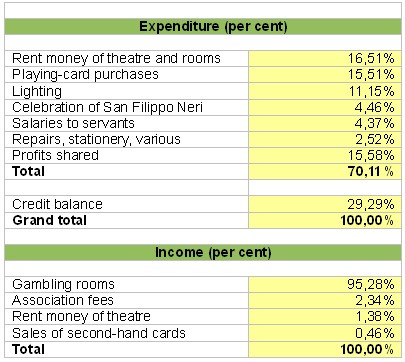
The entry of the rent money is actually formed by two terms, 13.83% of the theatre and 2.68% of the rooms rented from a different owner. Such being the case, it is possible to state that the highest expense was that for purchasing playing cards, with its 15.51%.
The cost of lighting – basically, candles and oil - was rather high, but of course card players could not interrupt their activity at twilight. The money spent for celebrations will be discussed below. The servants were two, Camillo Zucchetti and Niccolň Sansoni with a remarkably lower salary for the latter, assigned to Trucco.
Significant is the positive balance of the administration: 15.58% of the total was distributed as profit to the members of the academy, whereas almost a remarkable 30% was collected as net profit. Where did all this surplus money come from? Certainly not from the association fees, only reaching 2.34%.
A surprising 95.82% of all incomes came from the gambling rooms. There were separate contributions from Trucco and Carte. Here too the prevalence of playing cards may be surprising: no less than 92.70% from cards, just 3.12% from Trucco.
There is no entry from the theatre, except for a few cases in which it was subcontracted to managers, wishing to organise independent performances. However, the rent money received in these occasions only made a bare 1.38% of the incomes. In conclusion, it seems that the theatre of the academy was mainly used as an easier system for obtaining the licence required for the functioning of the gambling rooms associated to it.
Evidently, much more than from the visitors of the theatre, the profits came from the visitors of the gambling rooms. To the point that one may wonder how strict the selection of the players could reasonably have been; actually, by increasing the number of visitors, the profit of the member of the academy could remarkably increase. Some trace is kept in the books of quarrels, big noise, and players expelled.
Playing cards purchased
The individual records of card purchases are reported in the appendix below. The following table has been derived for the yearly total amounts, separately for Basse and Minchiate packs, as in the original records, with their sums added in the last column.
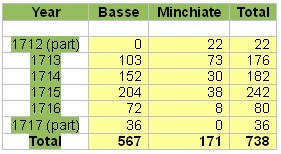
The total amounts divided by five gives as an average value per year 113 packs of Basse and 34.2 of Minchiate, with a 23% ratio of Minchiate to the total amount of playing cards. This way of deducing plausible values has been adopted in analogy with other academies recently studied, but it is evident from the appendix that the basis of the calculation is extremely weak in this case.
If we take into account the two years for which we find more complete data, the results for the mentioned ratio would be 41% in 1713 and 16% in 1715. It is clear that the fraction of Minchiate was diminishing, but what is the most evident observation is that initially only Minchiate were acquired for the academy, in several purchases, for several months.
It seems that Minchiate was initially the only card game in actual usage there. Only in the following months, ordinary cards entered the rooms, in increasing amounts. This observation can be confirmed by other expenses, to begin with some specific furniture acquired for playing particular card games more comfortably.
As suppliers of the cards, we first find cardmaker Francesco Rossi, followed by Giovanni Francesco Molinelli, both producing a remarkable part of all playing cards used in Tuscany at the time.
Furniture
Particularly significant for providing an insight into these playing rooms is the inventory of the furniture present there in 1817, listed in register No. 5, together with its estimated value to be transferred in the account books of the new Accademia dei Sorgenti, established in 1817 in Via dell’Anguillara - clearly using the opposite attribute, “rising” instead of “falling”.
- Un Trucco, il giuoco, palle, maglio, altro attinente al medesimo.
- Due tavolini di pietra nera fioriti di bianco.
- Un tamburo da asciugare le cartte.
- Due tondi per il Trentuno con sue panche attorno uno piů grande dell’altro.
- Due tavolini in noce in ottangolo da bambara.
- Due tavolini da ombre.
- Due cassette per i denari. |
We thus have a complete set for Trucco and several pieces of furniture for playing cards. Most remarkable are the tables used for card playing, because they were specifically made to have the players operating in a way as comfortable as possible.
The two small stone tables could have been different from card tables, because no specific use is indicated for them. However, at least six of eight tables certainly were card tables. What is rather unusual, is that they were three couples of tables made for specific card games, Trentuno, Bambara, and Ombre, respectively.
We find these tables recorded in register No. 3 too, with the corresponding suppliers and costs. It may be a significant evidence that most or all of them were acquired around November 1713, thus confirming that precisely by then an extraordinary increase of card playing took place in the academy.
The exact shape of the card tables for Ombre is not stated, and could even be different from its usual shape, suitable for three players. It is instead explained that the two tables for Trentuno were both round, one larger than the second one, and both equipped with their accompanying benches. For Bambara tables we have two indications, that they were made of exquisite walnut wood and that they had an octagonal shape.
There were moreover two cash boxes for the fees required for playing, and a cylindrical sieve used for drying the cards.
The patrons of the academy
Among the other items of the inventory it may be worthwhile to mention three portraits, which may directly show some useful connections: the Grand Duke, as could be expected, but especially the two patrons: patron saint, San Filippo Neri, and patron supporter, Prince Gian Gastone dei Medici, the upcoming last Grand Duke of the family.
Actually, every academy had a similar couple of patrons – heaven and earth helped together, and their combined assistance was effective to the point that even prohibited games became allowed.
Now, the advantages for having as a patron nobody less than the crown prince are easy to imagine. Less evident are nowadays the corresponding assistance by San Filippo. It is not easy for us to put ourselves in the shoes of the members of those academies. In particular, our first impression is that they could not act in good faith and that their appeals to the saint were a kind of gimmick for obtaining authorisations and licences.
The last interpretation can probably explain only a minor part of the situation, even though it is impossible to define how minor that could have been. The association of church services with leisure, gambling included, was then more immediate than one might expect now.
Let us limit the report and discussion to what is documented in these registers. The entry of 4.46% of the total expenditure ascribed to Celebration of San Filippo Neri was actually consisting in two different contributions. The first was really the yearly celebration of the Saint-day, essentially a reception with furnishings and refreshments – its total contribution was of 1.78%.
On the same day, they had a draw for assigning a dowry of 10 Scudi, in honour of the Saint. This was one of the most demanding tasks for every member of the academy: he had to select a Florentine girl with the required qualification to become a candidate. The draw on the Saint-day determined the winner, and this kind of tribute to San Filippo Neri covered 2.68% of the total expenditure of the academy.
CONCLUSION
Some documents of the years 1712-17 from the Accademia dei Cadenti of Florence have been studied, focusing the attention on card playing. In those years, no particular stage activity of the academy took place in their theatre in Corso Tintori, whereas card playing changed strongly from just Minchiate up to include not only Ombre, but also the often prohibited Trentuno and Bambara,
The profits from the game fees paid by card players covered no less than 92.7% of all the incomes of the academy. This had evidently been possible thanks to the management by the academy members of a theatre, which at the time allowed card playing to be tolerated.
Still more effective seemingly were the two associated patrons of the academy, San Filippo Neri, and Prince Gian Gastone dei Medici, whose portraits were kept in plain sight within the rooms.
Footnotes:
(1) Franco Pratesi: 1674-1685 – MINCHIATE AT THE EVANGELISTA ACADEMY (2012)
(2) Franco Pratesi: 1693-1698 – MINCHIATE AT THE AQUILOTTI ACADEMY (2012)
(3) Francesca Fantappič, Annali di Storia di Firenze, 3 (2011) 147-193. < Francesca Fantappič
Accademie teatrali fiorentine ... >.
(4) Francesca Fantappič, Medioevo e rinascimento, Vol. XII (2001) 241-274.
(5) Franco Pratesi: CARD PLAYING IN PRATO IN THE 18TH CENTURY (2013)
(6) ASFI, Inventario N/422. Libri di commercio e di famiglie, edited by Vanna Arrighi, Stefano Calonaci, and Veronica Vestri. 2008, 1843 pp.
(7) Franco Pratesi: FLORENTINE CARD PRODUCTION IN ABOUT 1840 (2011)
|
Accademia dei Cadenti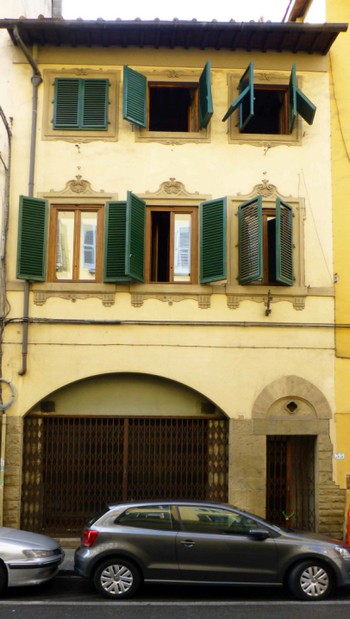
Florence, No. 35 of Corso Tintori
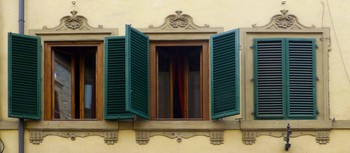
the theatre had been at the 1st floor
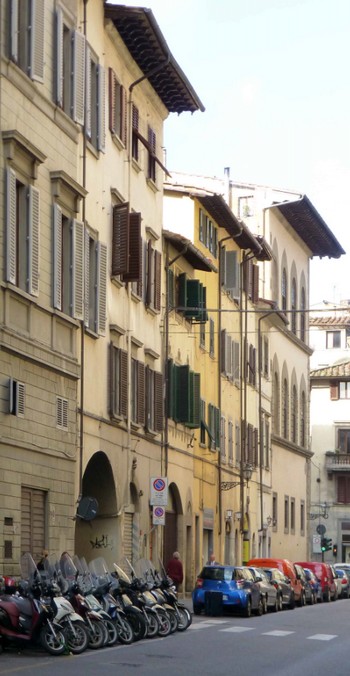
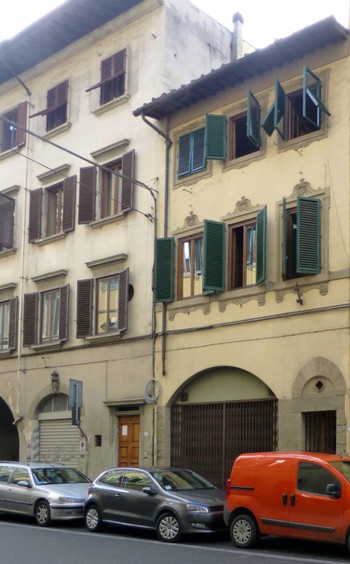
|
|


